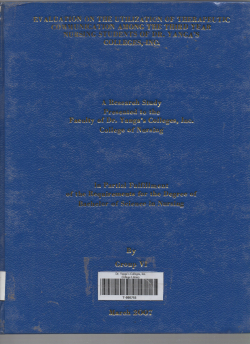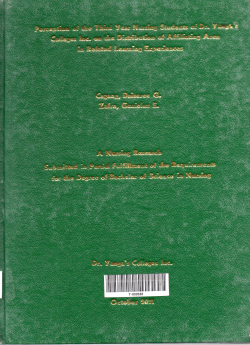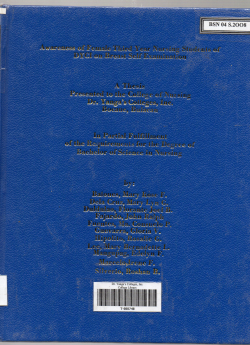EVALUATION ON THE UTILIZATION OF THERAPEUTIC COMMUNICATION AMONG THE THIRD YEAR NURSING STUDENTS OF DR. YANGA’S COLLEGES, INC.

Type
Thesis
Authors
Category
CHS
[ Browse Items ]
Subject
therapeutic communication
Abstract
The main objective of the study is to evaluate the use of therapeutic communication technique of the third year nursing students of Dr. Yanga’s Colleges, Inc.
The study followed mainly a descriptive type of research design. A descriptive survey type of research design specifically. Data were gathered from various print and non-print sources. The structured style of data gathering through questionnaires was also employed. The respondents of the study were 100 male and female third year nursing students of Dr. Yanga’s Colleges, Inc. The sample size was obtained using Slovin’s sample computation and cluster sampling as well. Statistical tools used were percentage, weighted arithmetic mean and Two- Tailed Test.
Therapeutic communication is greatly utilized and practiced by the students of Dr. Yanga’s Colleges. The communication process is vital to daily living and so is therapeutic communication to the nursing practice. Verbal communication is used more often than nonverbal communication. The communication process is viewed as an interchange of information, an act of receiving and giving thoughts, emotions and feelings. Therapeutic communication is viewed as an interpersonal communication between the nurse and the client whose main goal is to help the patient recover from disease and obtain his/her needs in the course of the illness or stay in the healthcare facility. This view is congruent with Imogene M. King’s Theory, also with some principles exhibited by Dorothea Orem’s theory. Trust is needed to have an effective nurse-client communication process while techniques incorporated with the use of humor, active listening, questioning and imparting information are the most preferred therapeutic communications techniques.
The researchers recommend that the students together with the effort of the school and its administrators continue to practice and apply therapeutic communication in the clinical setting. Moreover, the researchers recommend that the Center for Curriculum Development of the school should formulate or if not streamline the current curriculum to include a development program that focuses on the effective practice and use of therapeutic communication in the actual healthcare setting. Lastly, the researchers recommend that further studies, being wider in scope, be undertaken by interested parties specially those who are greatly concerned with establishing patent and harmonious nurse-client communication and relationship in the clinical setting.
The study followed mainly a descriptive type of research design. A descriptive survey type of research design specifically. Data were gathered from various print and non-print sources. The structured style of data gathering through questionnaires was also employed. The respondents of the study were 100 male and female third year nursing students of Dr. Yanga’s Colleges, Inc. The sample size was obtained using Slovin’s sample computation and cluster sampling as well. Statistical tools used were percentage, weighted arithmetic mean and Two- Tailed Test.
Therapeutic communication is greatly utilized and practiced by the students of Dr. Yanga’s Colleges. The communication process is vital to daily living and so is therapeutic communication to the nursing practice. Verbal communication is used more often than nonverbal communication. The communication process is viewed as an interchange of information, an act of receiving and giving thoughts, emotions and feelings. Therapeutic communication is viewed as an interpersonal communication between the nurse and the client whose main goal is to help the patient recover from disease and obtain his/her needs in the course of the illness or stay in the healthcare facility. This view is congruent with Imogene M. King’s Theory, also with some principles exhibited by Dorothea Orem’s theory. Trust is needed to have an effective nurse-client communication process while techniques incorporated with the use of humor, active listening, questioning and imparting information are the most preferred therapeutic communications techniques.
The researchers recommend that the students together with the effort of the school and its administrators continue to practice and apply therapeutic communication in the clinical setting. Moreover, the researchers recommend that the Center for Curriculum Development of the school should formulate or if not streamline the current curriculum to include a development program that focuses on the effective practice and use of therapeutic communication in the actual healthcare setting. Lastly, the researchers recommend that further studies, being wider in scope, be undertaken by interested parties specially those who are greatly concerned with establishing patent and harmonious nurse-client communication and relationship in the clinical setting.
Number of Copies
1
| Library | Accession No | Call No | Copy No | Edition | Location | Availability |
|---|---|---|---|---|---|---|
| Main | 521 | T Ev92 2007 | 1 | Yes |



